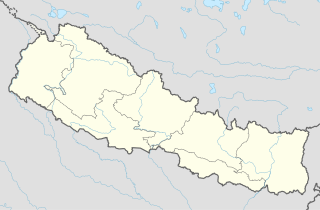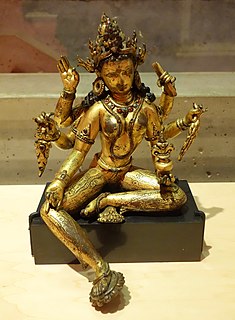
Kathmandu is the capital and second largest metropolis of Nepal in area, with a population of around 2.5 million.
Prince Nirajan Bir Bikram Shah Dev was a Prince of Nepal, younger brother of King Dipendra. Prince Nirajan and other royals were killed at a dinner in 2001. Nirajan was next in line to the throne after Dipendra.
Buddhism in Nepal started spreading since the reign of Ashoka through Indian and Tibetan missionaries. The Kiratas were the first people in Nepal who embraced Gautama Buddha’s teachings, followed by the Licchavis and Newars. Buddha was born in Lumbini in the Shakya Kingdom. Lumbini is considered to lie in present-day Rupandehi district, Lumbini zone of Nepal. Buddhism is the second-largest religion in Nepal. According to 2001 census, 10.74% of Nepal's population practiced Buddhism, consisting mainly of Tibeto-Burman-speaking ethnicities, the Newar. However, in the 2011 census, the Buddhist population in Nepal was just 9% of the country population. It has not been possible to assign with certainty the year in which Prince Siddhartha, the birth name of the Buddha, was born, it is usually placed at around 563 BCE. In Nepal's hill and mountain regions Hinduism has absorbed Buddhist tenets to such an extent that in many cases they have shared deities as well as temples. For instance, the Muktinath Temple is sacred and a common house of worship for both Hindus and Buddhists.

The Kathmandu Valley, historically known as Nepal Valley or Nepa Valley, lies at the crossroads of ancient civilizations of the Indian subcontinent and the broader Asian continent, and has at least 130 important monuments, including several pilgrimage sites for Hindus and Buddhists. There are seven World Heritage Sites within the valley.

Bhaktapur district (Nepali: भक्तपुर जिल्लाListen ; Nepal Bhasa : ख्वप देश located in the eastern part of Kathmandu valley, is the smallest among the seventy-seven districts of Nepal. It is part of Bagmati Pradesh. The district, with Bhaktapur as its district headquarters, covers an area of 119 km2 and in 2011 had a population of 304,651 of whom 9,701 people were absent.

Kathmandu District is a district located in Kathmandu Valley, Bagmati Pradesh of Nepal, a landlocked country in South Asia. It is one of the 77 districts of Nepal, covers an area of 395 km2 (153 sq mi), and is the most densely populated district of Nepal with 1,081,845 inhabitants in 2001 and 1,744,240 in 2011. The district's headquarter is Kathmandu Metropolitan City, also the capital of Nepal. It is also a famous tourist spot as there are many religious temples, attracting places.

Sindhupalchok District is a part of Bagmati Pradesh and one of the seventy-seven districts of Nepal, with an area of 2,542 km2 (981 sq mi). The district's headquarters is in Chautara. In 2006, 336,478 people resided in 79 village development committees, in 2011 there were 287,798.

Budhanilkantha School, often referred to as BNKS, is a public boarding school in Nepal. It is located in Narayanthan, 8 kilometres north of Kathmandu on the foothills of Shivapuri mountain. It is named after the Budhanilkantha Temple which is located nearby.

Bharatpur is a city in southern central Nepal with a population of 280,502. It is the fourth largest city in Nepal and the district headquarters of the Chitwan District, as well as a separate metropolitan authority.

Hetauda is a sub-metropolitan city in the Makwanpur District of Bagmati Pradesh in central Nepal. It is the administrative headquarters of the Makwanpur District and the Capital of Bagmati Pradesh as declared by majority Provincial Assembly Members on 12th January, 2020. It is one of the largest cities of Nepal. At the time of the 2015 Nepal census, it had a population of 153,875 people.
Tulsi Giri was the Prime Minister of Nepal from 1975 to 1977, and chairman of the Council of Ministers in 1963, and again in 1964 and 1965. He was born in Siraha District, Nepal in 1926. Tulsi was a Minister in the Congress government of 1959−1960 before its dissolution by King Mahendra. He became the first Prime Minister following the two-year period of Mahendra's direct rule. He studied at the Suri Vidyasagar College, when it was affiliated with the University of Calcutta. He received a medical degree prior to entering politics.

Budhanilkantha is a municipality in Kathmandu District of Bagmati province of Nepal that was established on 2 December 2014 by merging the former Village development committees Hattigauda, Khadka Bhadrakali, Chapali Bhadrakali, Mahankal, Bishnu, Chunikhel and Kapan. The city is situated at the foot of Shivapuri hill. At the time of the 2011 Nepal census, it had a population of 15,421.

'Khadka Bhadrakali was a village in Kathmandu District in the Bagmati Zone before being incorporated into city of Budhanilkantha. At the time of the 1991 Nepal census it had a population of 5539. On recent survey in 2011, the VDC had a total population of 10,761.
Rajopadhyaya is one of the five groups of Bramhans in Nepal. Witzel (1986) identifies the following five groups of Bramhans in Nepal, viz.
- the Newārī-speaking Rājopādhyāya Bramhan
- the Nepāli-speaking Kumāī Bramhan
- the Nepāli-speaking Pūrbiya Bramhan
- the Maithilī-speaking Maithil Bramhan
- the Bhaṭṭa Bramhan from South India as priests of Pashupatinath Temple

Budhanilkantha Temple, located in Budhanilkantha, Nepal, is a Hindu open air temple dedicated to Lord Vishnu. Budhanilkantha Temple is situated below the Shivapuri Hill at the northern end of the Kathmandu valley. and can be identified by a large reclining statue of Lord Vishnu. The temple's main statue of Budhanilkantha is considered the largest stone carving in Nepal.

The sculpture of Nepal is best known for small religious figures and ritual objects in bronze or copper alloy, but also has other strengths. The Newar people of Nepal had a long-lasting specialism in casting small bronze figures, mostly religious and especially Buddhist, considerable numbers of which were exported to India and Tibet over many centuries.

Pasikot, situated at Budhanilkantha Municipality, is a village in Budhanilkantha in Kathmandu District in Bagmati Pradesh before being incorporated into the city of Budhanilkantha in Nepal. At the time of the 2011 Nepal census it had a population of 15,421.










